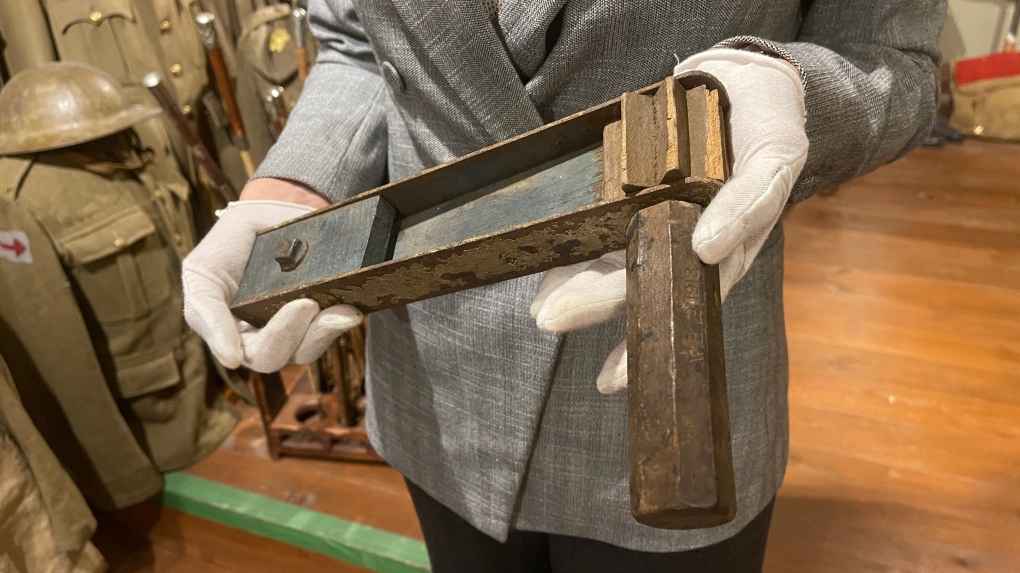Bullets, shell shock, and trifle desserts: Free Montreal exhibit shows life in First World War
Inside a densely-packed archive of First World War artifacts in Montreal, among the shelves of knives, razors, uniforms and artillery, there is a cookbook.
The book belonged to Clarence Booth, who lived on Peel Street. before he enlisted with the 24th Battalion Victoria Rifles in 1914. His friends called him Buster.
Two years later, he would fight in the disastrous Battle of St. Eloi. Canadian troops fought the Germans on a battlefield already riddled with craters formed by detonated mines. By the time Canadians arrived, the holes were filled with waist-deep water, which provided little cover from enduring gunfire during the two-week clash.
"Hid in shell holes," reads a passage in Booth's diary. "Got back okay. My nerves gone."
Booth survived the battle. He was later admitted to the hospital twice for shell shock — a condition doctors would later call PTSD. That diagnosis got him restationed into the kitchen, where he started keeping a log of recipes.
"He made a lot of pie," said Caitlin Bailey, executive director of The Vimy Foundation.
Booth lived through the war and died in June, 1961. The cause of his death is unknown. Much of what is known about his life is thanks to The Vimy Foundation. Next to his cookbook is his uniform, address books, and photos in his scrapbook.
For Bailey, his story is one of resilience and survival in a time fraught with horror.
The First World War was, and remains, one of humanity's bloodiest chapters. Some 8,500,000 soldiers died of wounds and disease. Families were pulled apart as young men, many of them teenagers, left home to fight.
Booth was one of them. Bailey says the foundation thinks he might have been just 16 when he enlisted. And after witnessing horrors on the battlefield, "Here's a man who's making cake," she said.
Inside the cookbook, there's a recipe for a raspberry trifle cooked with wine or sherry — chef's choice.
Elsewhere in the museum: a rollable checkers set, a saddle for equestrian travel, and metal-tongued noisemakers, which, when raised and twirled, make an upsetting clack-clack-clack sound, signalling an incoming poison gas attack.
The gas "kind of melts your lung tissues. So, you basically drowned in your lung fluid," said Bailey. "It was a horrible way to die."
 A closer look at a WWI noisemaker used to signal incoming poison gas attacks. Death by poison gas was 'horrible,' according to The Vimy Foundation's Executive Director, Caitlin Bailey (Luca Caruso-Moro, CTV News)
A closer look at a WWI noisemaker used to signal incoming poison gas attacks. Death by poison gas was 'horrible,' according to The Vimy Foundation's Executive Director, Caitlin Bailey (Luca Caruso-Moro, CTV News)
FREE EXHIBIT
The artifacts are on display for free until Nov. 10 at The Vimy Foundation's office at 5524 St. Patrick's St., on the second floor. A small assortment of artifacts is set up in the lobby, but staff are offering free tours of their storage rooms packed with historical items and stories.
The foundation is offering the viewings ahead of Remembrance Day this Saturday.
Its office is open from 9 a.m. to 5 p.m. Monday to Friday.
CTVNews.ca Top Stories

India's 'most wanted terrorist' arrested on gun charges in Canada
One of India's most wanted terrorists has been arrested and charged in connection with a recent alleged shooting in Ontario.
12-year-old boy charged in stabbing of 11-year-old boy at Edmonton McDonald's
The boy stabbed at a north Edmonton McDonald's last Friday is 11 years old.
What makes walking so great for your health and what else you need to do
Medical experts agree that walking is an easy way to improve physical and mental health, bolster fitness and prevent disease. While it’s not the only sort of exercise people should do, it’s a great first step toward a healthy life.
U.S. Congress hosts second round of UFO hearings
The U.S. government held another UFO hearing on Capitol Hill on Wednesday, the second such hearing in 16 months. This hearing was billed as an attempt by congress to provide a better understanding of what is known about previous sightings of UFOs, also known as UAPs (Unidentified Anomalous Phenomena).
Toronto teenager charged with first-degree murder in Kitchener, Ont. homicide
A Toronto teen has been charged as part of an investigation into Kitchener, Ont.’s first homicide of 2024.
Spy service officer denies threatening Montreal man who was later imprisoned in Sudan
A Canadian Security Intelligence Service official has denied threatening a Montreal man who was later imprisoned and allegedly tortured by authorities in Sudan.
Donald Trump picks Florida Rep. Matt Gaetz to serve as attorney general
President-elect Donald Trump on Wednesday said he will nominate Republican Rep. Matt Gaetz of Florida to serve as his attorney general, putting a loyalist in the role of the nation's top prosecutor.
This Canadian airline will adopt Apple's new AirTag feature to help recover lost baggage. Here's how
Apple announced that a new feature, 'Share Item Location,' will help users locate and recover misplaced items by sharing an AirTag location with third parties including airlines.
Canada bracing for 'tough' talks as Trump's pick calls northern border an 'extreme vulnerability'
The Canadian government is aware it's likely in for 'tough conversations' with U.S. president-elect Donald Trump's administration, after his border czar said there is 'an extreme national security vulnerability' he intends to tackle at the Canada-U.S. border.


































